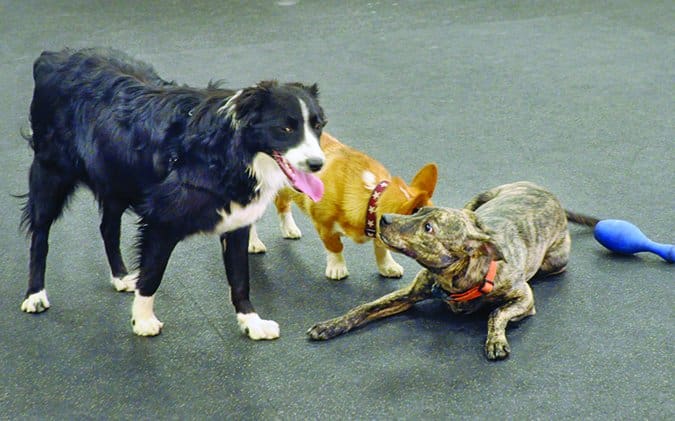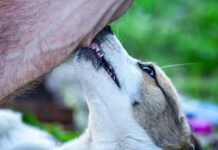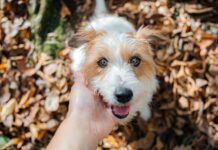Anorexia
Stress causes the appetite to shut down. A dog who won’t eat moderate to high-value treats may just be distracted or simply not hungry, but refusal to eat is a common indicator of stress.
Appeasement/Deference Signals
Appeasement and deference aren’t always an indicator of stress. They are important everyday communication tools for keeping peace in social hierarchies, and are often presented in calm, stress-free interactions. They are offered in a social interaction to promote the tranquility of the group and the safety of the group’s members. When offered in conjunction with other behaviors, they can be an indicator of stress as well. Appeasement and deference signals include:

Slow movement: appeasing/deferent dog appears to be moving in slow-motion
Lip-licking: appeasing/deferent dog licks at the mouth of the higher ranking member of the social group
Sitting/lying down/exposing underside: appeasing/deferent dog lowers body posture, exposing vulnerable parts
Turning head away, averting eyes: appeasing/deferent dog avoids eye contact, exposes neck

Avoidance
Dog turns away; shuts down; evades handler’s touch and treats.
Brow Ridges
Furrows or muscle ridges in the dog’s forehead and around the eyes.

Difficulty Learning
Dogs are unable to learn well or easily when under significant stress.
Digestive Disturbances
Vomiting and diarrhea can be a sign of illness – or of stress; the digestive system reacts strongly to stress. Carsickness is often a stress reaction.
Displacement Behaviors
These are behaviors performed in an effort to resolve an internal stress conflict for the dog. They may be observed in a dog who is stressed and in isolation – for example a dog left alone in an exam room in a veterinary hospital – differentiating them from behaviors related to relationship.

Blinking: Eyes blink at a faster-than normal rate
Nose-Licking: Dog’s tongue flicks out once or multiple times
Chattering teeth
Scratching
Shaking off (as if wet, but dog is dry)
Yawning
Drooling
May be an indication of stress – or response to the presence of food, an indication of a mouth injury, or digestive distress.
Get more details on excessive dog drooling here.
Excessive Grooming
Dog may lick or chew paws, legs, flank, tail, and genital areas, even to the point of self-mutilation.
Hyperactivity
Frantic behavior, pacing, sometimes misinterpreted as ignoring, “fooling around,” or “blowing off” owner.

Immune System Disorders
Long-term stress weakens the immune system. Immune related problems can improve when overall levels of stress are reduced.
Lack of Attention/Focus
The brain has difficulty processing information when stressed.

Leaning/Clinging
The stressed dog seeks contact with human as reassurance.
Lowered Body Posture
“Slinking,” acting “guilty,” or “sneaky” (all misinterpretations of dog body language) can be indicators of stress.
Mouthing
Willingness to use mouth on human skin – can be puppy exploration or adult poor manners, but can also be an expression of stress, ranging from gentle nibbling (flea biting) to hard taking of treats, to painfully hard mouthing, snapping, or biting.

Obsessive-Compulsive Disorders
These include compulsive imaginary fly-snapping behavior, light- and shadow-chasing, tail-chasing, pica (eating nonfood objects), flank-sucking, self-mutilation, and more. While OCDs probably have a strong genetic component, the behavior itself is usually triggered by stress.
Panting
Rapid shallow or heavy breathing is normal if the dog is warm or has been exercising, otherwise can be stress-related. Stress may be external (environment) or internal (pain, other medical issues).

Stretching
To relax stress-related tension in muscles. May also occur as a non-stress behavior after sleeping or staying in one place for extended period.
Stiff Movement
Tension can cause a noticeable stiffness in leg, body, and tail movements.

Sweaty Paws
Damp footprints can be seen on floors, exam tables, rubber mats.
Trembling
May be due to stress – or cold.
Whining
High-pitched vocalization, irritating to most humans; an indication of stress. While some may interpret it as excitement, a dog who is excited to the point of whining is also stressed.
Yawning
Your dog may yawn because he’s tired – or as an appeasement signal or displacement behavior.







My nearly 4 year old Labrador (neutered at 1) has in the last few days decided to hump dogs, usually medium sized or larger. Some don’t mind but the owners of course do mind! I’m not sure what the cause is. Is it physical or behavioural or both? Nothing has changed in his routine. The only way I can make him stop is by grabbing his colour and yanking him to me telling him ‘no’. I’m not sure if this is the right way of dealing with this. Have you any clues please?